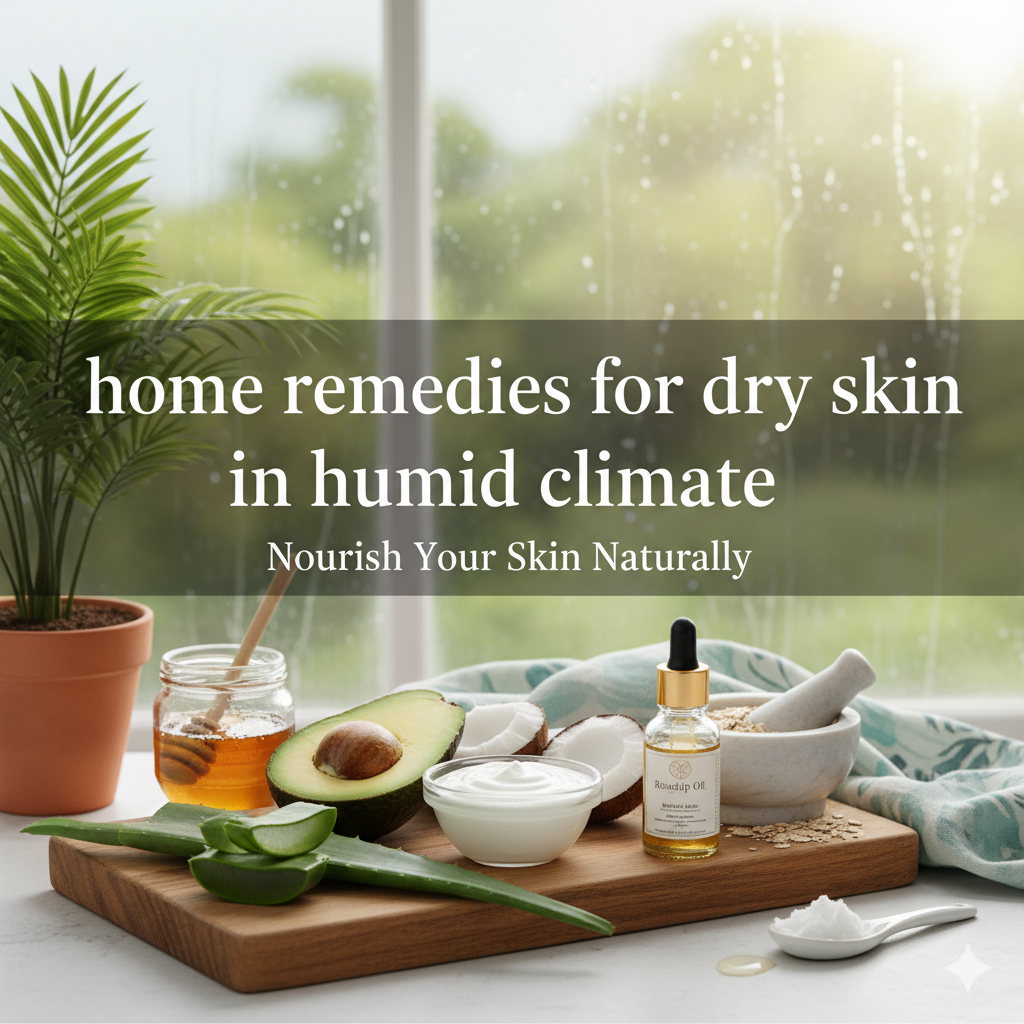Simple, effective home remedies for dry skin in humid climate
Living in a humid place can be confusing for your skin — you expect oiliness, but sometimes the result is tight, flaky patches instead. If you’re wondering what helps, these home remedies for dry skin in humid climate are practical, cheap, and easy to test at home.
In this guide you’ll get a short, science-backed explanation of why dryness happens even when the air is moist, quick fixes you can do today, a daily routine that balances hydration without clogging pores, and a concise FAQ so you can stop guessing and start treating your skin. These home remedies for dry skin in humid climate recommendations focus on restoring the skin barrier and locking in moisture without making your skin feel sticky.
Read on for gentle, realistic steps you can use right away — whether you have dry hands, flaky cheeks, or tight skin after a day out — plus a simple shopping list of ingredients to keep at home. Use these home remedies for dry skin in humid climate to make your routine both effective and comfortable.
Why dry skin can happen in humid places
Even when humidity is high, several things can make your skin lose moisture: over-washing with hot water, harsh soaps that strip oils, sun damage, air-conditioning that dries indoor air, and a damaged skin barrier (which lets water escape). Trusted medical sources note that protecting the skin barrier and avoiding over-bathing are core strategies to prevent xerosis (dry skin). Mayo Clinic+1
Quick, safe home remedies you can try today
-
Use a gentle, fragrance-free cleanser — swap foamy, stripping soaps for a mild, pH-balanced cleanser so you don’t remove natural oils. (Cleveland Clinic / AAD guidance). Cleveland Clinic+1
-
Moisturize immediately after washing — while skin is still slightly damp, apply an occlusive moisturizer to seal moisture in (petroleum jelly, ceramide creams, or a rich lotion). This is one of the simplest, most effective measures. Healthline+1
-
Try natural humectants and occlusives — small amounts of aloe vera gel for soothing, sunflower oil or coconut oil (patch-test first) as light occlusives, and oatmeal baths for full-body soothing are widely recommended home options. Healthline+1
-
Shorten and cool your showers — lukewarm showers for 5–10 minutes prevent stripping oils and reduce water loss. Harvard Health highlights shower duration and temperature as key factors. Harvard Health
A practical daily routine (for humid climates)
-
AM: Rinse with lukewarm water or a gentle cleanser → pat dry → apply a lightweight, non-comedogenic moisturizer (look for humectants like hyaluronic acid and barrier ingredients like ceramides). If you’ll be in the sun, finish with sunscreen. bluemercury+1
-
PM: Cleanse to remove sweat/airborne grime → treat any dry patches with a thicker cream or an occlusive (e.g., petroleum jelly) → consider a lightweight facial oil or sleeping mask only where needed.
-
As needed: Use overnight hand cream and wear cotton gloves while sleeping to help absorption; avoid heavy makeup on irritated areas.
Ingredients and products to look for
-
Humectants: hyaluronic acid, glycerin — draw water into skin.
-
Ceramides & fatty acids: restore barrier function.
-
Occlusives: petrolatum, mineral oil, shea butter — lock moisture in.
-
Soothing botanicals: aloe vera, colloidal oatmeal (useful for itchy, inflamed dryness).
Reputable dermatology sources and clinical overviews back these ingredient classes for dry skin care. Cleveland Clinic+1
What to avoid
-
Hot showers and frequent scrubbing. Harvard Health
-
Strong alcohol-based toners or fragranced products that can strip oils.
-
Too many active exfoliants (AHAs/BHAs) if your skin barrier is already compromised.
When to add a humidifier or adjust indoor settings
If your home is heavily air-conditioned or you find dryness indoors (especially at night), a small humidifier set to a comfortable level can help skin retain moisture. Harvard Health and other clinical sources recommend controlling indoor drying factors (temperature, long hot showers) as part of a skin-care plan. Harvard Health+1
One-minute emergency fix for tight, flaky skin
Gently cleanse the area with lukewarm water, pat dry, apply a thin layer of petroleum jelly or a rich cream while skin is still damp, and avoid exfoliation for 48 hours. Repeat twice daily until the area calms.
FAQs
Q: Will oily skin in humid climates still get dry?
A: Yes. Skin can be dehydrated (water loss) while still producing oil. Treat dehydration with humectants and barrier repair rather than stripping cleansers. Cleveland Clinic
Q: Are natural oils safe for all skin types?
A: Some oils (sunflower seed oil, light mineral oil) are safer for sensitive or dry skin; coconut oil can clog pores for acne-prone people — patch-test first. Medical News Today
Q: When should I see a dermatologist?
A: See a clinician if dryness is severe, painful, bleeding, recurrent, or not improving with consistent home care — persistent xerosis can hide eczema or other conditions. Cleveland Clinic
Quick shopping list
-
Fragrance-free gentle cleanser
-
Ceramide-containing cream (small tub)
-
Lightweight humectant serum (hyaluronic acid)
-
Petroleum jelly or occlusive balm
-
Colloidal oatmeal (for baths)
-
Small humidifier (optional)
Conclusion
When the air is sticky but your skin feels tight, these home remedies for dry skin in humid climate focus on repairing the skin barrier, using humectants and occlusives, and preventing further moisture loss. (keyword mention 4/7) Keep your showers short and lukewarm, moisturize while skin is damp, and use gentle, non-stripping cleansers to see fast improvement. These home remedies for dry skin in humid climate are simple to implement and, when used consistently, will help your skin feel comfortable again. (keyword mention 5/7) If a patch doesn’t improve after consistent care, consult a dermatologist — they can rule out eczema or other conditions and tailor stronger treatments. Use these home remedies for dry skin in humid climate as your starting routine and adjust based on how your skin responds.


